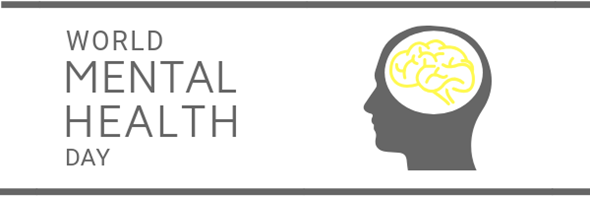World Mental Health Day,
October 10, 2019
Today, October 10, is World Mental Health Day.
As time goes on, awareness efforts to normalize discourse about mental health have been incredibly successful. Though stigma still persists, it is no longer shocking to see candid reporting about depression and other mood disorders, especially as we come to grips with just how common depression is.
Unfortunately, reporting on mental health often clusters a variety of disorders together without clarifying how they may differ from, or relate to, each other. For today’s e-mail, we want to look more closely at the difference between depression and anxiety, two related but distinct disorders that often go hand in hand.
All of us will face moments in life when we have a depressed mood or are especially anxious. These are completely natural emotions, and in some cases can even serve a purpose to help us. But when someone experiences a distressing amount of depression or anxiety over a sustained period of time, they often will be diagnosed with a medical mood disorder.
Major Depressive Disorder*
MDD affects some 18 million adults in the US each year. It is a type of mood disorder which manifests in the following symptoms:
- Changes in sleep
- This can mean too much (hypersomnia) or too little sleep (insomnia)
- Changes in appetite
- Lack of concentration
- Loss of energy
- Lack of interest in activities
- Hopelessness or guilty thoughts
- Changes in movement
- Lethargic movement or excess fidgeting
- Physical pain
- Like headaches or muscle soreness
- Suicidal thoughts
- Not all people with depression experience suicidal thoughts, contrary to popular belief, but it is still a common symptom
According to the most recent Diagnostic and Statistical Manual (the DSM V), to be a major depressive episode, someone has to experience five or more of the above symptoms.
Anxiety **
Anxiety affects over 40 million adults in the US per year. Anxiety is a group of disorders, the most common of which are:
- Generalized Anxiety Disorder (GAD)
- Social Anxiety Disorder
- Panic Disorder
- Phobias
Anxiety, even more so than depression can be broken down into:
- Possible Physical Symptoms
- Pounding or racing heart
- Shortness of breath
- Sweating
- Tremors/Twitches
- Headaches
- changes in sleep, much like depression
- Gastrointestinal issues
- Upset stomach, diarrhea, frequent urination
- Possible Emotional Symptoms
- Feelings of apprehension or dread
- Feeling tense or jumpy
- Restlessness or irritability
- Anticipating the worst
Anxiety, unlike a lot of mental illnesses, can feel intensely physical; as a result it is sometimes discounted or mistaken for a physical illness. That is why it’s important to break down anxiety into physical and emotional symptoms, as we’ve done here.
Comorbidity ***
Though anxiety disorders and depressive episodes are, as you see above, distinct from one another, they frequently go hand in hand. When two disorders occur at once they are considered comorbid. According to some research, up to 60% of people with anxiety will experience depressive symptoms, and vice-versa. The treatments for depression and anxiety are also frequently the same, as both disorders can be helped by talk therapy and SSRIs (Selective Serotonin Reuptake Inhibitors), more commonly called antidepressants.
Though we don’t completely understand why anxiety and depression occur together in so many people, we do know that both in some way involve the serotonin neurotransmitter in the brain, meaning the neurological causes may be similar. This likely explains why similar medications can help in treating both disorders.
If you are interested in learning more about specific types of depressive episodes or anxiety disorders, we encourage you to consult useful websites like NAMI (National Alliance on Mental Illness), NIMH (National Institute for Mental Health) or the DSM V itself.
We hope that this email has helped to illuminate the different symptoms of depression and anxiety, as well as the similarities in terms of circuits in the brain. On November 6 we will explore the issue further at our HOPE Luncheon Seminar focused on “Depression and Anxiety: Diagnosis and Latest Treatments.” We hope you will join us – you can purchase tickets here.


